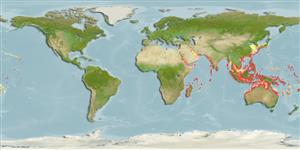Common names from other countries
>
Syngnathiformes (Pipefishes and seahorses) >
Syngnathidae (Pipefishes and seahorses) > Syngnathinae
Etymology: Hippocampus: Greek, ippos = horse + Greek,kampe = curvature (Ref. 45335).
More on author: Bleeker.
Environment: milieu / climate zone / depth range / distribution range
Ecologia
marinhas; estuarina associadas(os) a recifes; não migratória; intervalo de profundidade 0 - 68 m (Ref. 37816), usually 0 - 8 m (Ref. 90102). Tropical; 39°N - 28°S, 32°E - 154°W (Ref. 57009)
Indo-Pacific: southern Africa, the Red Sea to Hawaii and French Polynesia; north to Japan, south to Australia.
Comprimento de primeira maturação / Tamanho / Peso / Idade
Maturity: Lm 14.0 range ? - ? cm
Max length : 30.0 cm TL macho/indeterminado; (Ref. 1602)
Descrição suscinta
Chaves de identificação | Morfologia | Morfometria
Espinhos dorsais (total) : 0; Raios dorsais (total) : 17 - 18; Espinhos anais: 0; Raios anais : 4.
Inhabit seagrass and marine algae areas of estuaries and seaward reefs; also on steep mud slopes. Found in open water and attached to drifting Sargassum up to 20 km from shore. Adults in pairs (Ref. 48635). Benthic to pelagic (Ref. 58302). Feeds on zooplankton (Ref. 85309). Ovoviviparous (Ref. 205). The males carry the eggs in a brood pouch which is found under the tail (Ref. 205). Not shown to be monogamous in the laboratory (Ref. 30915). Very popular aquarium fish. Highly valued species in traditional Chinese medicine (Ref. 30915). Has been reared in captivity (Ref. 35416).
There are 20 - 1000 larvae in incubating sacks; time of development is 20-28 days. The males carry the eggs in a brood pouch which is found under the tail (Ref. 205).
Lourie, S.A., R.A. Pollom and S.J. Foster, 2016. A global revision of the seahorses Hippocampus Rafinesque 1810 (Actinopterygii: Syngnathiformes): taxonomy and biogeography with recommendations for further research. Zootaxa 4146(1):1-66. (Ref. 115213)
Status na Lista Vermelha da UICN (Ref. 130435)
Ameaça para os humanos
Harmless
Uso pelos humanos
Pescarias: altamente comercial; Aquacultura: espécies comerciais; Aquário: Espécies comerciais
Ferramentas
Relatórios especiais
Baixar XML
Fontes da internet
Estimates based on models
Preferred temperature (Ref.
115969): 21.3 - 29, mean 27.8 (based on 1008 cells).
Índice de diversidade filogenética (Ref.
82804): PD
50 = 0.5000 [Uniqueness, from 0.5 = low to 2.0 = high].
Bayesian length-weight: a=0.00447 (0.00177 - 0.01127), b=3.00 (2.78 - 3.22), in cm Total Length, based on LWR estimates for this (Sub)family-body shape (Ref.
93245).
Nível Trófico (Ref.
69278): 3.6 ±0.5 se; based on size and trophs of closest relatives
Resiliência (Ref.
120179): médio(a), tempo mínimo de duplicação da população 1,4 - 4,4 anos (tm=0.6; Fec=20-1000).
Fishing Vulnerability (Ref.
59153): Low vulnerability (15 of 100).
